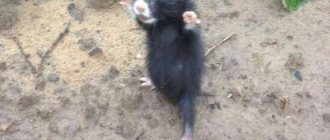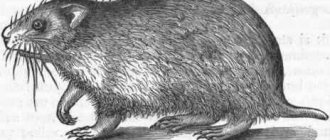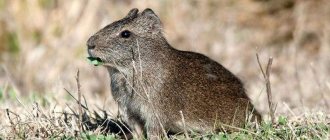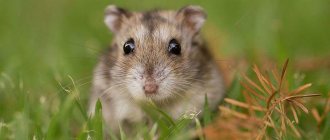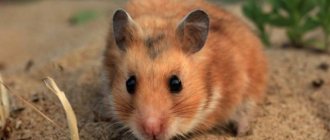And it looks like a funny animal... The carbysh differs from the domestic hamster in its size and character. Moreover, his character is not for the better. Wild hamsters are very aggressive. Watching the video, the thought arises that they completely lack a sense of fear and the instinct of self-preservation. Take a look for yourself:
In addition to the “standard” coloring, which you see in the photo in the title of the article, they can be completely black. In any case, it is a malicious crop pest. The field hamster stores up to 20 kg of vegetables and fruits for the winter, robbing fields and vegetable gardens. But we will talk about the problems that wild hamsters cause to owners of fields and gardens a little later. And now, as one smart person said, “You need to know the enemy by sight.”
He reminds me of someone. Some kind of Kung Fu Panda.
The structure and appearance of a wild hamster
The size of an adult male is 32-34 cm in length, weighing up to 700 grams.
Females are smaller, but also superior to domestic species. The body is dense and rounded, the neck is small, the transition from the body to the head is smooth. The tail is thick, tapering towards the tip, 3-8 cm long. The legs are short, but the animal can jump 20-30 cm. At the ends of the developed fingers there are hard claws, which it uses for digging holes.
There are hard antennae on the muzzle. The ears are round. Like all rodents, hamsters' teeth wear down and grow throughout their lives. The body is covered with dense hair and undercoat. The color is predominantly yellow and brown with dark and white spots. Occasionally, black steppe hamsters are found.
Types of hamsters in nature
There are 19 species of hamsters in total. They differ in size, habitat and lifestyle.
Ordinary
The wild hamster, known as the karbysh, is the most common member of the subfamily. Behind its funny and attractive appearance lies a dangerous pest that often plagues gardeners and farmers. Overgrown animals can cause irreparable damage to the crop. They hibernate during the winter. The common hamster stores abundant food reserves (cereals, nuts, corn, root vegetables).
Karbysh is a dangerous pest of agricultural crops.
Dzungarian
These animals have become widespread as pets. The body length of the dwarf is up to 10 cm. The rodent weighs 30-40 g. The animals can be easily distinguished by the dark stripe that runs from head to tail. At the top of the head it widens and takes the shape of a triangle, which goes down to the nose. The predominant coat color is smoky gray with small white spots. Some breeds have fur of bluish and red tints.
The animals are well adapted to captivity, but require attention and care. If your home is not cleaned on time, an unpleasant odor may appear.
Syrian
Syrian hamsters are also popular as pets. The size of an adult animal reaches 12-13 cm. Most often there are specimens with golden fur, but the color can be white, black or silver. “Syrians” are distinguished by their attractive appearance and easily adapt to life at home. They love to communicate with humans and never show aggression. Like many other relatives, the peak activity of hamsters occurs at night.
The Syrian hamster is a popular pet.
Habitat
The distribution area includes the zone of steppes and meadows of Europe, Crimea, the Caucasus, and Siberia. Rodents live in China, Kazakhstan, and Mongolia. The wild hamster is a typical inhabitant of open spaces.
The reduction in forest area and the increase in agricultural land contributes to the spread of rodents.
Animals are beginning to colonize anthropogenic landscapes. Hamsters appear in gardens, fields and dachas. If there is not enough food, karbysh settle in farm and residential buildings.
Wild hamster burrow
The forest hamster lives in burrows. At the same time, he prefers not to dig them himself, but to take them from smaller animals - voles or gophers. The hamsters then rearrange them as they see fit. The depth of the hole reaches 2 m and has up to 10 exits. The animal uses them in case of danger. The hamster burrow has several compartments:
- living space where the animal rests;
- pantries in which food supplies are stored;
- sheer entrance;
- inclined exits.
Pantries contain supplies of food that hamsters eat in winter and early spring. The rest of the year, rodents eat fresh vegetables and fruits.
Construction of a wild hamster burrow.
Hamsters are known for their cleanliness. They insulate the floor of their home with dry grass. As animals become dirty, they change their bedding.
There is a simple but effective way to check whether an animal lives in a discovered hole. You need to find a long stick and place it inside the shelter. If cobwebs or moss are found on it, the hole is most likely uninhabited, because... Hamsters always keep their home clean.
Everywhere is good
And finding such places for him is not a problem. The carbysh hamster, a photo of which is in our article, is found in a vast territory extending from Europe to China. He lives in the mountains and steppes, as well as on the shores of reservoirs. Despite the fact that it digs holes, it prefers dense rather than loose soil. Karbysh (hamster) loves gardens and vegetable gardens. It is there that he finds the most abundant and delicious food. And these animals need a lot of it, because they multiply quickly and their numbers are rapidly increasing. If you do nothing, then soon the entire area will be a desert, and the forest hamsters will move to a new place.
Duration and lifestyle
Under natural conditions, carts live up to 4 years. In captivity, this period can increase by 1 year. The abundance of food, good care and the absence of predators have a beneficial effect on the life expectancy of rodents.
Hamsters prefer to live alone and do not tolerate the proximity of their relatives. They jealously guard their territory. During daylight hours, animals rest in burrows.
Field hamsters are aggressive and fearless. For example, an animal can fight back against small dogs and cats. In moments of danger, the hamster stands on its hind legs, clicks its teeth and makes threatening sounds. Pushing off the ground with its hind legs, it can attack the enemy in a jump. Although animals avoid encounters with people, in case of hunger they can enter populated areas in search of food.
Inhumane ways
Some summer residents or home owners do not want to waste their time catching the animal. Therefore, they use aggressive methods aimed at driving away the hamster by causing it physical suffering or destroying it. One of these methods is to pour ash into a hole. Perhaps not all people do this out of cruelty. Some believe that the hamster simply cannot stand the smell of ash or does not want to walk around dirty, so it leaves its habitual place. In fact, when the animal gets dirty, it begins to lick its skin and the ash gets into its digestive organs, causing pain. After several similar procedures, the hamster begins to associate its suffering with an unknown powder in its hole and on its fur coat and leaves its home.
Hamsters are also poisoned with poison or lime mixed with sugar, which leaves burns on the esophagus. There are also traditional methods of getting rid of rodents. For example, mix wheat flour and alabaster, a white powder used in construction. Find the entrance to the hole and leave a bowl of “treats” near it, and place a drinking bowl with water nearby. The forest hamster will try the mixture and will definitely want to drink, and in the stomach the alabaster will begin to thicken and harden, which will lead to the death of the animal.
Reproduction and offspring
The breeding season for hamsters lasts from April to October. A male often mates with several females. Partners find each other by smell. The meeting of two males ends in a fight. The losing opponent leaves, the winner mates with the female. After fertilization, the male immediately leaves the expectant mother. He does not take any part in caring for the offspring. Pregnancy lasts 15-20 days. Up to 20 cubs are born at one time. Like other rodents, hamsters are fertile and can produce 2-4 litters per year.
Rodents reproduce very actively; a litter usually contains 6–20 cubs.
Hamsters are born naked and with their eyes closed, but develop quickly. After only 10 days they begin to see clearly, and after 2 weeks they are covered with fur. At first they feed on milk, then the mother begins to feed the offspring fresh greens. Females protect the cubs until the animals are able to take care of themselves. Having reached the age of 3 weeks, young hamsters leave their native nest in search of territory to live.
Lots of kids
Individuals reach sexual maturity at 20 weeks. Offspring are born in the spring. One litter can have from 6 to 18 cubs. If the weather is favorable, the female can give birth several times. Babies are born blind, bald and helpless, but very quickly begin to grow up and enter adult life. One male carbysh fertilizes several females at once. So you can roughly calculate how many hamsters there will soon be in one area if you don’t get rid of them, considering that they live in the wild for about 4 years.
Population and conservation status
In recent years, the number of animals has been actively declining. Scientists note a population decline due to decreased fertility. Previously, there were often up to 20 cubs in a litter, now the average is 3-4. The likely cause is human use of pesticides in agriculture.
In Belgium, Germany, Poland, the Netherlands, France, and Ukraine, the forest hamster is protected and listed in the Red Book. Programs are being implemented to restore the population. On the territory of Russia, the animal is protected in 5 constituent entities of the federation. In other regions (Kazakhstan, Siberia, Rostov region, Crimean Peninsula), the number of rodents remains at a high level.
Differences between a wild hamster and a domestic one
Field and domestic hamsters have a similar body structure. The difference lies in the size of the animals: carbysh are larger and heavier. Wild hamsters have longer and more massive ears. They are clearly visible on the rodent's body.
Another important difference is the nature of the animals. If an ordinary domestic hamster is a docile and calm animal that gets used to its owner and allows itself to be controlled, a wild relative is aggressive and unpredictable. Even with females, hamsters get along only during the breeding season. Karbysh do not tolerate proximity to other animals.
Ultrasonic repellers
Ultrasonic repellers are considered one of the humane ways to combat wild hamsters. Installed on a summer cottage, they do not kill the animal, but only emit ultrasonic waves of various frequencies, which are not perceived by humans, but are very unpleasant for rodents. Repellers that constantly act on the ears of the hamster force the animal to leave its habitat, thereby protecting the plantings and future harvest.
The most popular models of ultrasonic repellers are:
- “Electrocat” - in addition to ultrasound, it also produces light flashes that greatly frighten rodents.
- "Grad" is a repeller with ultrasonic and sound waves, and also has the effect of a flickering light beam.
- "Typhoon". Having a coverage area of more than 200 m, it is able to work in both sound and silent modes, reliably repelling small rodents.
Some gardeners prefer not to install on the surface, but to bury ultrasonic repellers in the ground, but this method does not always give a good result, since in this situation the repellers have a greater effect on moles and mice, but have practically no effect on Karbysh.
Is it possible to keep a wild hamster at home?
Wild rodents are not adapted to life at home. The animal can show unmotivated aggression at any moment and bite a person. Even if caught as a baby, the garden hamster cannot be tamed.
The steppe hamster is a wild animal, so it cannot be tamed.
Wild animals should live in nature, and they should not be forced to change their usual way of life. Such experiments most often end sadly for both animals and humans. It is much easier to buy a pet hamster at any pet store.
Distribution area
The common hamster, also called the field hamster, lives on the Eurasian continent, mainly in the steppe and forest-steppe zones.
In the south of Europe, the natural border of distribution of this species of mammals is the coast of the Azov and Black Seas, in Asia - deserts and semi-deserts, the foothills of the Tien Shan and Altai. The common hamster is not found north of the Yaroslavl and Kirov regions in the European part of Russia, or the Yekaterinburg - Tobolsk - Krasnoyarsk line in Western Siberia.
Be sure to read:
Can a hamster eat tangerines
? The rodent chooses to live in the outskirts of fields, river valleys (not swampy ones), gardens and park areas. It settles near people, for example, in dachas. But most of all, steppes with an abundance of grasses and cereals suit him.
What to do if bitten by a wild hamster
Like other wild rodents, hamsters are natural carriers of various diseases dangerous to humans. Its saliva contains pathogens of almost 30 diseases. The bite of a field hamster is dangerous to humans and other domestic animals. Long sharp teeth leave poorly healing wounds with ragged edges.
Fleas that live on the body of wild animals and spread tularemia, Brucella, salmonella and other diseases pose a great danger.
If you are bitten by a steppe hamster, you must immediately wash the wound with running water and soap. Then treat the edges with a disinfectant, such as iodine or hydrogen peroxide.
It is possible that skin redness and swelling may form at the site of the bite. In some cases, a person may have a rise in body temperature and difficulty breathing. To prevent serious consequences, you should contact a medical facility for emergency care as soon as possible.
The wound from a hamster bite should be washed immediately with running water and soap.
Or maybe it's not worth it?
This little guy has an aggressive disposition. He is capable of attacking even humans. In case of danger, he does not run away, but attacks, gnashing his teeth, making whistling sounds, puffing out his cheeks and jumping on the enemy. Not every pet wants to be bitten on the nose. Hamster teeth leave very painful lacerations. In addition, he, like many rodents, is a carrier of about 30 infections. If they get into the blood of a person or animal, then everything can end in death. Karbysh are quite large and strong, and a cat cannot handle them. A Chihuahua dog is also unlikely to defeat the animal. But there are specially trained rat-catching dogs that can cope with this task. So you should trust the professionals and not put your pets at risk.
Why wild hamsters may appear in the countryside
The reason why steppe hamsters settle in a garden or country house is related to the way of life of the animals. The period of harvest ripening coincides with the beginning of the rodents' preparation of reserves for the winter. The abundance of root crops, fruits and vegetables attracts animals from nearby fields. The presence of carbysh is indicated by the following signs:
- burrows that have appeared in the garden, which are wider in hamsters than in moles or shrews;
- digging in beds with carrots, beets and other root vegetables;
- damaged bark in the lower part of the trunk of fruit trees;
- Traces of rodent teeth appear on vegetables and fruits;
- characteristic marks on the ground.
Why is this necessary?
If we already understand who the karbysh are, how to fight them is not yet clear. And most importantly, why do it. It is believed that there is nothing superfluous in nature. But if the forest hamster Karbysh, whose photos are very cute, settles on your site, you will think differently. First, let's figure out what these animals eat. They are omnivores, they can eat both plant foods and larvae, insects, frogs, lizards, and snakes. But still, their favorite food is seeds, grains, root vegetables, grass, and plant roots. Therefore, if your garden is attacked by a carbysh, a rodent whose purpose of life is to obtain food, then you can only feel sorry for your potatoes, zucchini, pumpkin, strawberries and other garden crops.
You may even be left without seedlings. After all, although these animals hibernate in their burrows at the end of October, they come to the surface with the beginning of the first thaw, which means that seedlings from your site will be the first to feed them. With their teeth, like scissors, they cut off plantings, preventing them from growing. Karbysh penetrate into cellars, spoiling and destroying stocks of potatoes, carrots and beets, even if they are located at a depth of 1.5 - 2 meters. In addition, they drag earth into the cellars, polluting it and causing inconvenience to the owners.
Fighting methods
To get rid of carbysh living in the garden, several methods are used. Hamsters are smart and careful, so success lies in a simultaneous combination of different methods.
Chemicals
The use of poisoned baits reduces the number of pests. To combat carbysh, you can use poisons for rats and mice. The disadvantages of this method are that the bait can be eaten by pets. In addition, in order to destroy all the rodents, it is necessary for each of them to try the poison.
Rat and mouse poisons can be used to kill wild hamsters.
Ultrasonic repellers
Various repellents emit sounds that pests cannot tolerate in the VHF range. Such devices do not have a negative impact on humans. Before purchasing a device, you should carefully read its description and technical characteristics. This is a humane and effective method, but at the same time costly from an economic point of view. To protect a large area you will need several expensive repellers.
Mechanical devices
Traps and live traps are used to catch pests. This method should be used if the number of animals is small. It should be remembered that hamsters are cautious and timid, so it is not easy to lure them into a trap.
If the rodent does not fall into the trap, you can try ancient methods of control. This is, for example, flooding a hole with water. You must first block all detected outputs. A hunter is located near one hole. Then they pour water into the shelter until the karbysh comes out of it. At this moment you can catch him.
For the success of the operation, it is important to barricade all exits from the rodent’s shelter, otherwise the pest will escape through the escape hole.
Friends of Man
They say that if there is a cat or dog in your summer cottage, then you are not afraid of rodents, because the smell of a cat or dog alone repels mice and rats. Not to mention the fact that your friends will consider it a pleasure to hunt in nature, stretch their legs and present their owners with the caught prey. Who hasn't heard the story of how a cat scared its owner by bringing her a freshly caught mouse? Or about a dog digging holes and destroying moles. Perhaps some of them are true, but you should know that catching a rodent is not so easy. Your pet will have to work hard. In addition, some people do not want to do this or simply cannot. Especially when it comes to karbysh.
Prevention measures
To prevent the appearance of carbysh in the country, it is recommended to take the following preventive measures:
- regularly clean the garden area and prevent the formation of deposits of branches and debris;
- after harvesting, immediately remove the fruits to the basement or home;
- Get a large breed dog or cat that can repel rodents.
A large breed cat will help scare away a wild hamster in your garden.
Interesting Facts
The hamster is an interesting animal with a large number of interesting facts associated with it:
- cheek pouches can accommodate up to one-fifth of the thrifty animal’s body weight;
- hamsters are born with teeth that continue to grow throughout their lives;
- domestic species are able to distinguish their owners by smell and even remember their name;
- one year for a hamster is equal to 25 years of human life;
- herbivorous rodents obtain protein by eating insects, worms, and eggs of small birds;
- in Vietnam there is a legal ban on keeping hamsters at home due to their ability to spread infectious diseases;
- animals have poor eyesight, but excellent sense of smell and hearing;
- cells that are extracted from the ovaries of Chinese hamsters are used to produce drugs for sclerosis and chronic lymphocytic leukemia;
- rodents are able to swim by taking air into their cheek pouches;
- Stocks in pantries can reach 90 kg.
The forest hamster, despite the harm it causes to farmers, is a funny animal that attracts attention with its appearance and habits.
Where does he live?
His house is spacious. The burrow of a carbysh can reach 8 meters wide and 1.5 meters deep. Considering that this animal is solitary, its mansions are simply magnificent. Inside his home he has a “bedroom” and storage rooms in which he stores grain supplies. It is interesting that he puts each variety separately, and does not throw it out of his cheek pouches into a common pile. Despite the fact that the carbysh is a hamster that prefers to live alone, it can share a place of bread with its relatives if it finds an area with a lot of tasty food.
